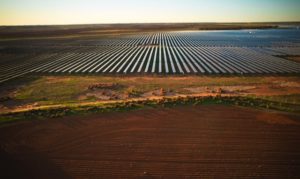A team of Australian National University scientists has brought economically competitive, grid-scale solar thermal energy generation closer to reality, after achieving a new record in efficiency for the technology that could compete with the cost of electricity from fossil fuels.

The ANU team, whose CST technology harnesses the power of the sun using a 500 square meter solar concentrator dish, made the breakthrough by redesigning the system’s receiver in a way that halved its convection losses and boosted its conversion of sunlight into steam from 93 per cent to 97 per cent.
According to the ANU’s Dr John Pye, the new design could result in a 10 per cent reduction in the cost of solar thermal electricity.
“Ultimately the work in this project is all about reducing the cost of concentrating solar thermal energy,” he said. “Our aim is to get costs down to 12 cents per kilowatt-hour of electricity, so that this technology will be competitive.
“I’m optimistic that our technology can play a role in the grid, by helping to provide power at night without fossil fuel power stations running.”
The team, from the ANU Research School of Engineering is part of a broader group of scientists working in the area, with funding from the Australian Renewable Energy Agency, to generate cheaper base-load electricity from renewable energy sources.
“When our computer model told us the efficiency that our design was going to achieve, we thought it was alarmingly high. But when we built it and tested it, sure enough, the performance was amazing.”

At 500 square metres, the ANU solar concentrator is the largest of its kind in the world, and works by focussing the power of 2,100 suns onto the receiver, through which water is pumped and heated to 500°C. The energy is stored in molten salt.
The team’s new receiver design is described as “a cavity that resembles a top hat with narrow opening and a wide brim.
When sunlight is focused onto the pipes, it heats the water as it enters at the brim and spirals up into the cavity, reaching peak temperature deep inside the cavity, thus minimising heat loss.
Heat that does leak out of the cavity can be absorbed by the cooler water around the hat’s brim, the team said.
“The overall efficiency of this receiver, with the measured as-built dish optics and at the reference solar elevation angle of 30° …was 98.7%,” the report said.
“This accounts for reflection, emission and convection losses, and is a ratio of the heat absorbed by the working fluid to the total reflected solar irradiance incident upon the receiver surface.”
The ANU team says it has already had commercial interest in the solar thermal system.
The receiver design was presented at the SolarPACES 2015 conference, a full paper is available here.










